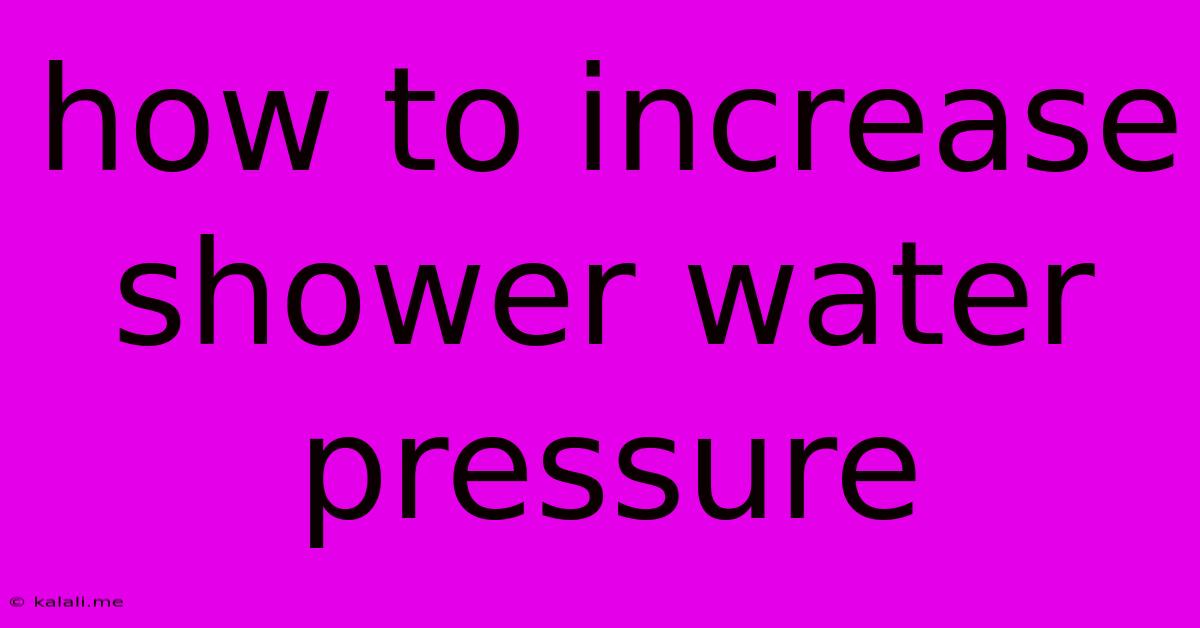How To Increase Shower Water Pressure
Kalali
May 21, 2025 · 4 min read

Table of Contents
How to Increase Shower Water Pressure: A Comprehensive Guide
Low water pressure in your shower can be incredibly frustrating. A weak, sputtering stream can ruin your morning routine and leave you feeling less than refreshed. Luckily, there are several ways you can boost your shower's water pressure without calling in a plumber – and often without spending a fortune. This guide will explore various methods, from simple checks to more involved fixes, helping you achieve the invigorating shower you deserve.
Understanding Low Water Pressure: The Root Causes
Before jumping into solutions, it's crucial to understand why you might be experiencing low water pressure. Several factors can contribute, including:
- Sediment buildup: Mineral deposits and debris can accumulate in your showerhead, restricting water flow.
- Clogged pipes: Corrosion, mineral buildup, or even foreign objects within your pipes can significantly reduce water pressure throughout your home, not just in the shower.
- Low water pressure from the main supply: Issues with your city's water supply or problems with your home's main water line can impact pressure throughout your entire plumbing system.
- Faulty showerhead: A damaged or poorly designed showerhead can restrict water flow even with adequate pressure from the main supply.
- Restricted pipes: Kinks or bends in your pipes can impede water flow. This is more likely if your home is older and has undergone multiple plumbing changes.
Simple Solutions to Boost Shower Pressure
Let's start with the easiest and most cost-effective solutions:
1. Clean Your Showerhead: The Quick Win
This is the first thing you should try. A buildup of mineral deposits (lime scale) and soap scum dramatically reduces water flow. Follow these steps:
- Remove the showerhead: Carefully unscrew the showerhead from the pipe. Keep a bucket handy to catch any residual water.
- Soak and scrub: Soak the showerhead in a solution of white vinegar and water (equal parts) for 30-60 minutes, or overnight for stubborn buildup. Use a small brush or old toothbrush to scrub away any remaining deposits.
- Rinse thoroughly: Once clean, rinse the showerhead thoroughly with water.
- Reinstall: Carefully screw the showerhead back onto the pipe.
2. Check the Water Pressure Throughout Your Home: Identifying the Source
If your low pressure is affecting other fixtures besides your shower, the problem likely stems from a larger issue within your plumbing system, rather than an isolated problem in your shower itself. Check faucets and other water outlets to determine if the problem is widespread.
3. Examine Your Showerhead's Design: Low-Flow Showerheads
Some low-flow showerheads, designed to conserve water, may produce a weaker spray even if your water pressure is perfectly normal. Consider switching to a high-pressure showerhead that features multiple spray patterns and adjustable settings.
More Involved Solutions for Persistent Low Water Pressure
If cleaning your showerhead and checking your home's water pressure don't resolve the issue, you might need to explore more advanced solutions:
4. Check for Clogged Pipes: Investigating the Plumbing System
If you suspect clogged pipes, you'll need to investigate further. This might require using a plumber's snake (a flexible auger) to clear out any blockages. If the blockage is severe or in an inaccessible area, you'll want to call a professional plumber.
5. Consider a Water Pressure Booster Pump: A Significant Upgrade
A water pressure booster pump is a more significant investment but can dramatically increase water pressure throughout your home. These pumps are installed on your main water line and increase the pressure before the water reaches your fixtures.
6. Replace Your Showerhead: The Upgrade Solution
If you’ve cleaned your existing showerhead and still have low water pressure, consider upgrading to a high-pressure showerhead. These showerheads are designed to maximize water flow, even with moderate water pressure. Look for models with multiple spray settings and adjustable pressure.
Conclusion: A Stronger Shower Awaits
Low shower water pressure is a common problem, but often easily solved. By systematically checking the factors listed above, you can pinpoint the cause and implement the right solution – whether it's a simple cleaning or a more involved upgrade. Remember to always prioritize safety and, if unsure about any plumbing repairs, consult a qualified plumber. Enjoy your revitalized shower!
Latest Posts
Latest Posts
-
How Far Is St Pancras From Euston Station
May 21, 2025
-
How Long Does A Dog Take To Decompose
May 21, 2025
-
Can An Octopus Live Outside Of Water
May 21, 2025
-
What Does Bible Say About Pork
May 21, 2025
-
Do Washing Machines Heat Their Own Water
May 21, 2025
Related Post
Thank you for visiting our website which covers about How To Increase Shower Water Pressure . We hope the information provided has been useful to you. Feel free to contact us if you have any questions or need further assistance. See you next time and don't miss to bookmark.